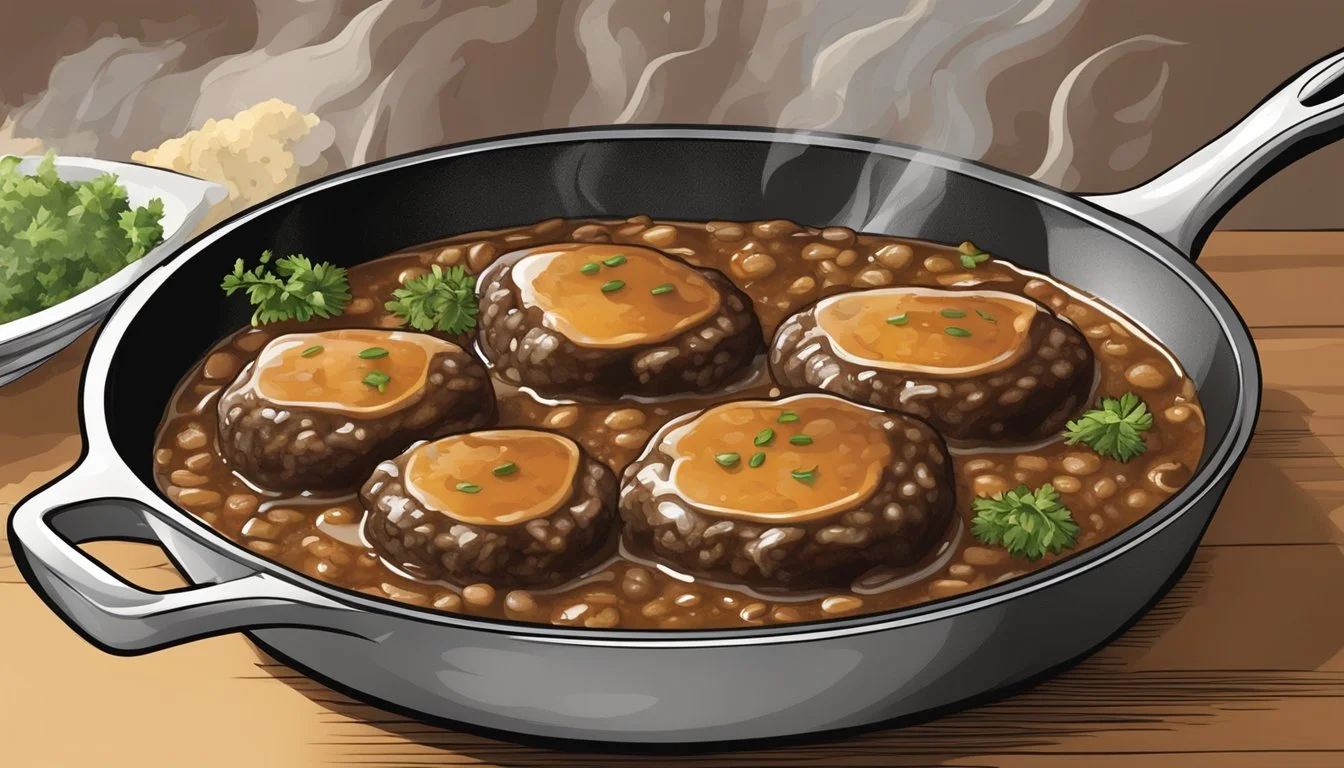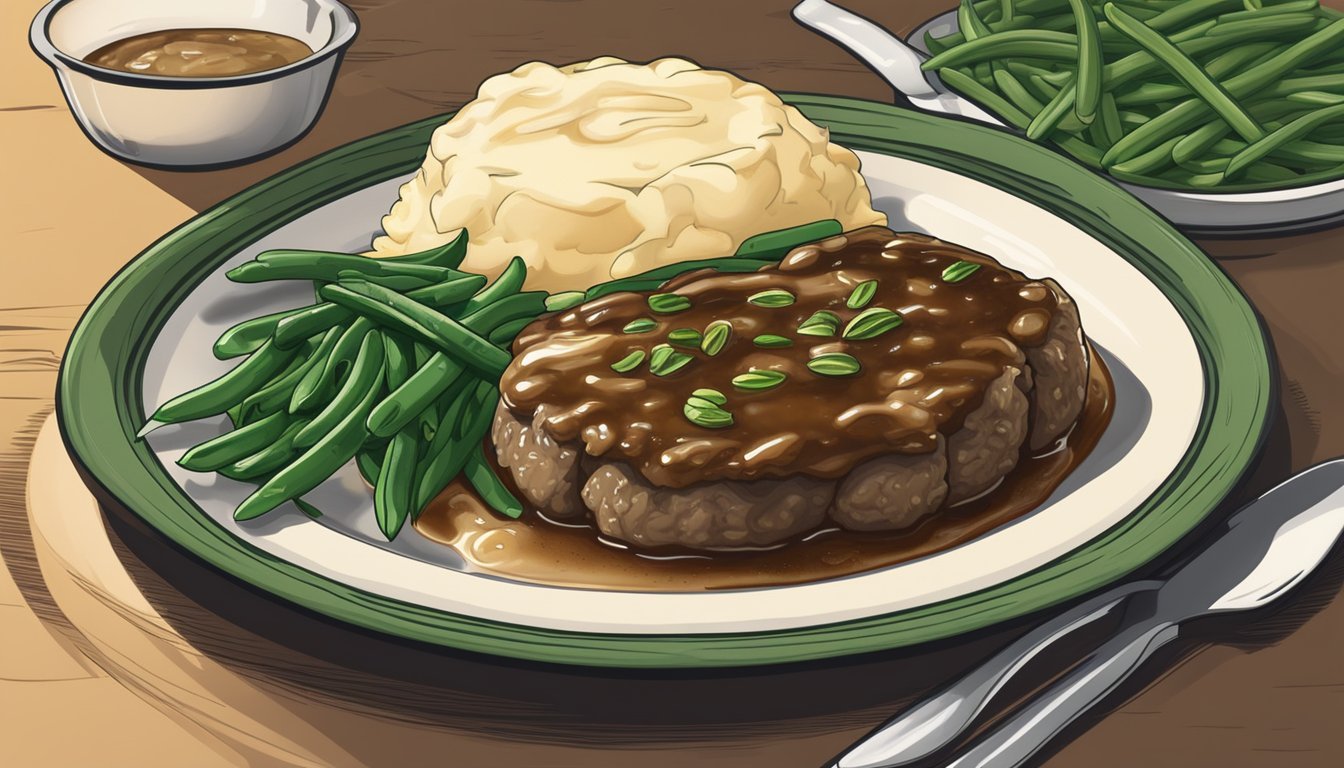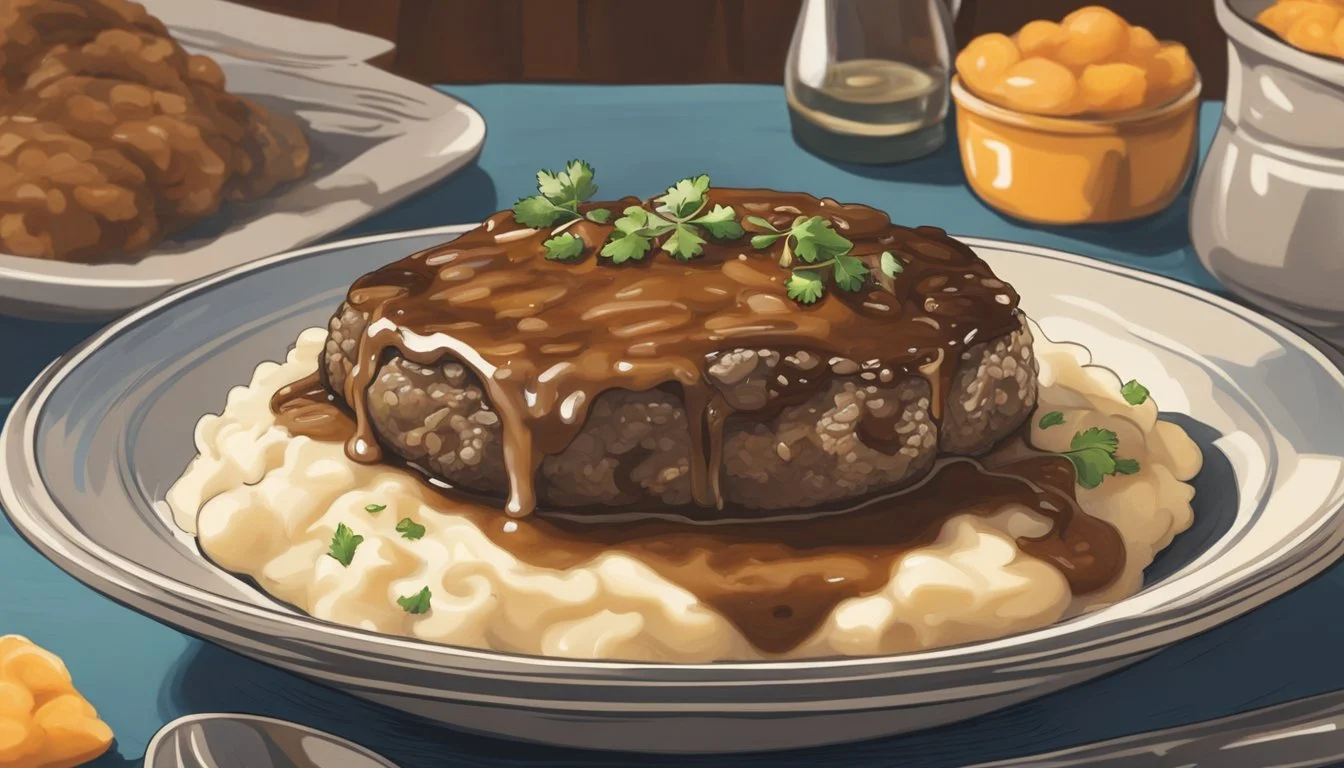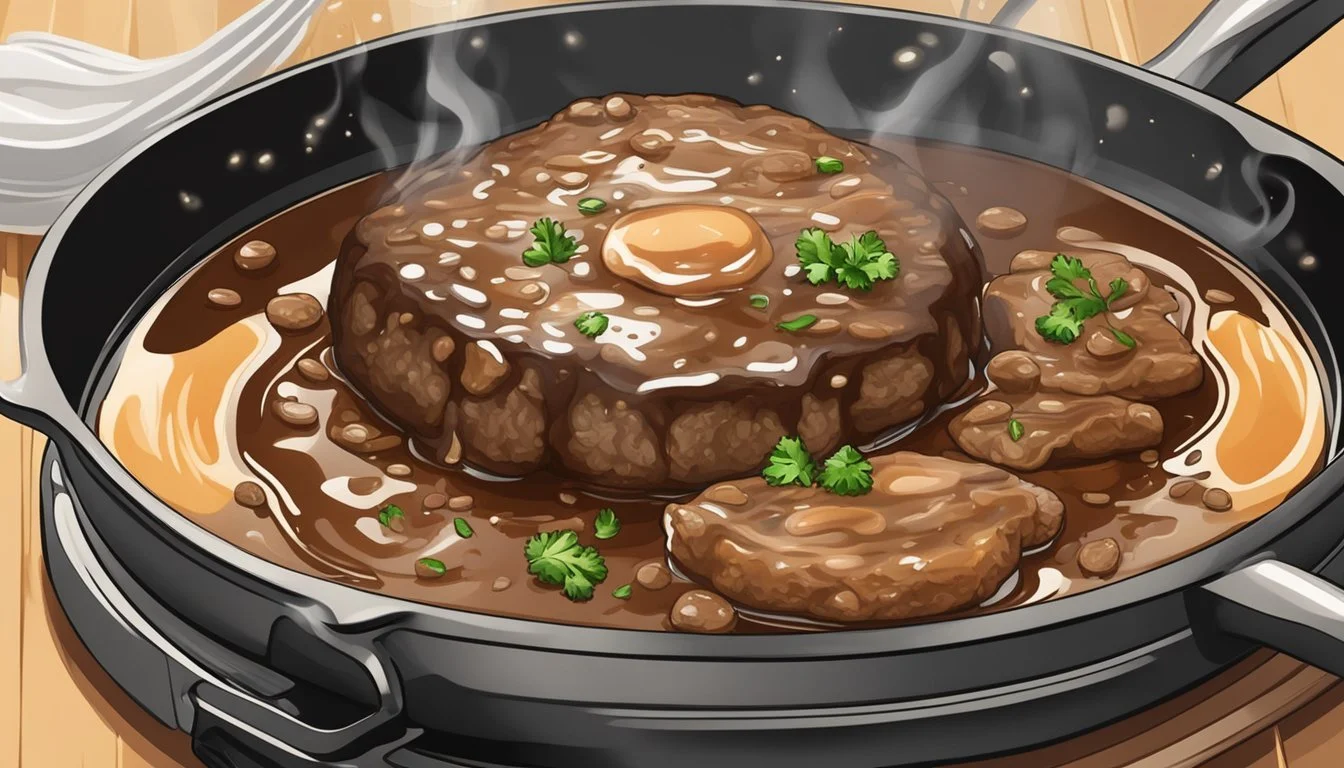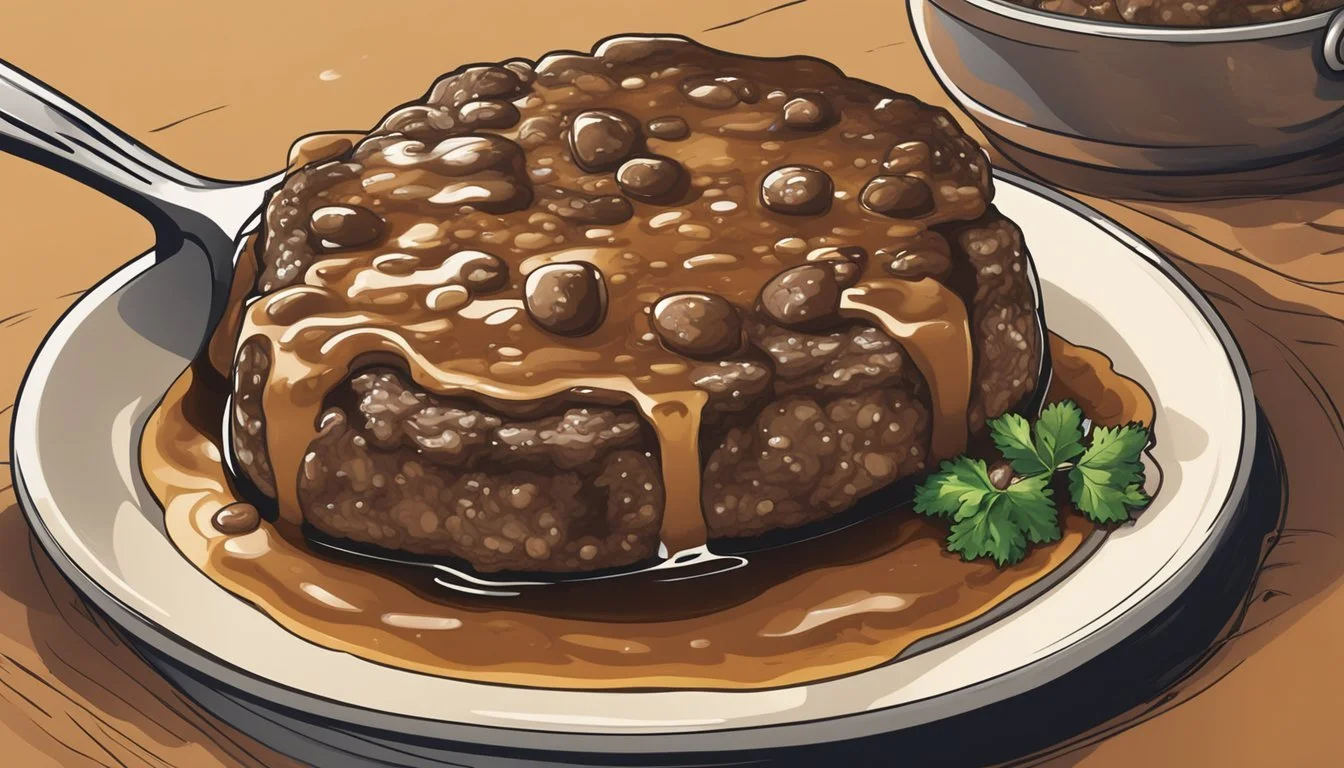Best Way to Reheat a Salisbury Steak
Tips for a Flavorful, Moist Meal
Salisbury steak is a beloved comfort food, celebrated for its rich, savory gravy and tender beef patty. Originally created by Dr. James Henry Salisbury as a health food in the 19th century, this dish has stood the test of time, becoming a staple on dinner tables and in diners across the country. It satisfies cravings for something hearty and home-cooked, offering a taste that's both familiar and deeply satisfying.
Proper reheating of Salisbury steak is crucial to maintaining the quality of the meal, especially when it comes to preserving the texture of the meat and the richness of the gravy. The key is to apply gentle heat in a way that ensures the beef patty remains moist and the gravy doesn't separate or become too thin. Successfully reheating this dish without compromising its flavors requires careful attention to method and timing.
Several approaches can be taken to reheat Salisbury steak, whether using an oven, a skillet on the stovetop, or a microwave. Each method has its advantages, and choosing the right one can make a significant difference in the outcome. The objective is to warm the steak thoroughly while keeping the gravy as luscious as when it was first prepared.
Understanding Salisbury Steak
Salisbury Steak is a savory dish consisting of seasoned ground beef patties served with a rich gravy.
Defining Salisbury Steak
Salisbury Steak is made from a blend of ground beef, with ingredients like breadcrumbs, an egg, and Worcestershire sauce to add flavor and bind the meat together. It is typically shaped into patties and cooked until browned. The steak is most often accompanied by mushroom gravy, a flavorful addition made from ingredients that may include beef broth, dijon mustard, and ketchup.
History of Salisbury Steak
The creation of Salisbury Steak dates back to the 19th century, named after Dr. James Henry Salisbury. He recommended eating ground beef for various health issues, which led to the popularization of this dish. Over time, Salisbury Steak became a staple in American cuisine, commonly found in diners and frozen dinners.
Nutritional Value
The nutritional content of Salisbury Steak varies depending on the specific recipe used, but key components generally include:
Proteins: The main source is the ground beef in the patties.
Carbohydrates: These often come from the addition of breadcrumbs and binders.
Fats: Present in the ground beef and any added oils or butter.
Vitamins and Minerals: Ingredients like onion and garlic provide essential nutrients.
Nutrient Source Proteins Ground beef Carbohydrates Breadcrumbs, Gravy, Ketchup Fats Ground beef, Gravy Vitamins Onions, Garlic Minerals Beef broth, Beef bouillon
While the dish can be a hearty and comforting meal, it is important to be mindful of portion size and gravy content to manage calorie intake.
Preparation Essentials
When reheating Salisbury steak, ensuring the gravy stays rich and the meat remains flavorful starts well before the reheating process. Choosing the right ingredients and utilizing effective techniques during initial preparation are critical to a delicious outcome.
Selecting Ingredients
To achieve the best flavor for Salisbury steak, one must select high-quality ingredients. The foundation of the dish is the meat, and ground beef is the traditional choice. For a leaner option, ground turkey may be used. Panko breadcrumbs are ideal for creating a lighter, airier texture in the patties, while cremini mushrooms add depth to the gravy. Incorporating a bold seasoning blend, including salt, pepper, garlic powder, and parsley, enhances the meat's taste.
Meat: Ground beef or ground turkey
Breadcrumbs: Panko preferred
Mushrooms: Cremini for rich flavor
Seasoning: Salt, pepper, garlic powder, parsley
Mixing and Forming Patties
Combining the mince with simple ingredients like bread soaked in milk (panade), Worcestershire sauce, and a hint of mustard ensures a moist, seasoned meat mixture. Form the beef or turkey mixture into meatballs and then flatten them into beef patties. Uniformity in size and thickness means even cooking.
Combine: Mince with panade, Worcestershire, mustard
Form: Meatballs, then flatten into evenly sized patties
Cooking Techniques
The initial sear of the patties locks in flavor and adds a desirable texture to the Salisbury steak. Use a skillet with a small amount of olive oil, cooking each patty until browned before setting aside. The next step is to build the gravy, ideally in the same pan to incorporate the fond, using a slurry of beef stock and cornstarch to thicken it and achieve a rich consistency. The patties are then returned to the pan and simmered in the gravy, melding the flavors together.
Sear: Brown patties in olive oil
Gravy: Thicken beef stock with cornstarch in the same pan
Simmer: Return patties to pan, cooking in gravy until flavors blend
Reheating Salisbury Steak
Reheating Salisbury Steak allows you to enjoy a flavorful meal with a gravy that keeps its rich consistency. Proper reheating on a stovetop or in a microwave ensures the steak remains juicy and delicious.
Pre-Reheat Steps
Before reheating your Salisbury steak, it's important to bring the steak to room temperature. This can significantly reduce reheating time and help avoid uneven heating. For those who have stored their leftover Salisbury steak in a refrigerator, they should set it out on the counter for about 15-20 minutes.
Stovetop Reheating Method
To reheat Salisbury steak on the stovetop, one should prioritize maintaining moisture:
Gather Ingredients/Equipment:
Nonstick skillet
Beef broth
Procedure: a. Place a nonstick skillet on the stove over medium heat. b. Add a few tablespoons of beef broth to create steam during the reheating process. c. Once simmering, add the Salisbury steak. d. Heat the steak, flipping after a few minutes to ensure even warming.
This method helps the Salisbury steak remain moist and prevents drying out.
Microwave Reheating Method
For a quick reheat, the microwave method is a suitable choice, especially for a homemade Salisbury steak ready to be enjoyed with minimal wait:
Preparation:
Make a slit in the film cover if reheating a prepackaged meal.
Place the Salisbury steak on a microwave-safe dish.
Microwaving Steps: a. Set the microwave to medium heat to prevent overcooking. b. Heat the steak in 30-second intervals, flipping it between intervals. c. Continue heating for up to 2 minutes, depending on the microwave’s power and the steak's thickness.
This method is ideal for times when one desires a quick and easy reheating option. However, the steak may not retain as much moisture as with the stovetop method, so one should consider covering the steak with a microwave-safe lid or damp paper towel to help retain moisture.
Creating a Rich Gravy
A rich gravy complements Salisbury steak, transforming it from a simple meat dish to a comforting meal. The key to a successful gravy lies in its base ingredients, its depth of flavor, and the right consistency.
Homemade Gravy Basics
To begin making homemade gravy, one needs to create a roux. This involves melting butter over medium heat and adding flour to it, stirring the mixture until it forms a paste. This paste should be cooked for a few minutes until it achieves a light golden color.
Ingredients:
Butter: 2 tablespoons
Flour: 2 tablespoons
Broth (beef or chicken): 2 cups
Salt: to taste
Pepper: to taste
Instructions:
Melt the butter over medium heat.
Stir in the flour to form a roux.
Gradually add broth, whisking continuously.
The roux serves as a thickener for the gravy, to which one adds liquid, typically beef or chicken broth, to form the base of the gravy. It's important to whisk continuously while adding the liquid to avoid lumps.
Enhancing Gravy Flavor
For a flavorful mushroom gravy, one can add finely diced mushrooms to the roux before incorporating the liquid. Lean ground beef drippings, if available, add richness and depth. Seasoning with salt and pepper is essential, but one may also consider ingredients like Worcestershire sauce or a splash of heavy cream for added complexity.
Flavor Enhancers:
Sautéed mushrooms
Beef drippings
Worcestershire sauce (1 tablespoon)
Heavy cream (optional for richness)
Keep tasting and adjusting the seasonings as the gravy simmers to ensure a balance of flavors.
Gravy Consistency and Adjustment
Sometimes, gravy may either be too thin or too thick. To correct this, use a slurry made of equal parts cold water and cornstarch. Gradually add the slurry to the gravy while it's simmering, stirring continuously for the gravy to reach the desired consistency.
Consistency Adjustment:
Cornstarch: As needed
Cold water: Same amount as cornstarch
Thickening: Combine cornstarch with water to make a slurry; stir it into the gravy for a thicker texture. Thinning: If gravy is too thick, gently add more broth or water until it reaches the right consistency.
Remember to always bring the gravy to a gentle boil after adding the slurry and simmer for a couple of minutes to cook off the raw cornstarch taste.
Accompaniments and Side Dishes
Selecting the right side dishes enhances the overall dining experience, creating a harmonious meal. Here's how to pick the perfect complements and ensure sides are reheated to perfection alongside Salisbury steak.
Picking the Perfect Sides
Key ingredients for side dishes that pair well with Salisbury steak include creamy mashed potatoes which offer a buttery texture that melds with the steak’s rich gravy. Incorporating butter and roasted onions can add depth to the potato's flavor. A rice medley provides a lighter starch alternative that can hold similar savory notes when cooked with herbs and butter. For vegetables, green bean casserole offers a creamy and crisp contrast, whereas asparagus steamed and tossed with a bit of butter or olive oil provides a fresh, snappy complement. If one seeks comfort and warmth, buttermilk biscuits can serve as a delightful vessel for sopping up gravy.
Reheating Sides Along with Steak
When reheating sides like mashed potatoes or rice, they should retain their moisture. Mashed potatoes may require an addition of milk or cream and a dollop of butter during reheating to ensure they remain creamy and do not dry out. Rice can be sprinkled with a little bit of water and covered before reheating to restore its fluffiness. As for vegetables, if they were initially roasted or sautéed, a quick warm-up in a pan or a short duration in the microwave should suffice to bring out their natural flavors without overcooking them. It's imperative to carefully monitor veggies to ensure they maintain their intended texture.
Food Safety and Storage
Ensuring the proper handling of leftover Salisbury steak goes beyond maintaining its flavor—it is crucial for safety. Attention to correct refrigeration and freezing practices, as well as vigilant measures to prevent foodborne illness, ensures that reheated Salisbury steak is not only tasty but safe to consume.
Proper Refrigeration and Freezing
Leftover Salisbury steak should be stored in the refrigerator within two hours of cooking to prevent bacterial growth. It should be placed in a shallow, airtight container or securely wrapped in plastic wrap or aluminum foil to maintain quality and prevent contamination. For optimal safety and quality, consume refrigerated leftovers within three to four days.
If the steak will not be consumed within this timeframe, freezing is an option. To freeze Salisbury steak, one should:
Cool the steak to room temperature (but not exceeding the two-hour window).
Wrap the steak and gravy separately in plastic wrap or freezer bags, pressing out as much air as possible.
Label the wrapped steak with the date and contents before placing it in the freezer.
Salisbury steak can be stored in the freezer for 3 to 4 months. Thaw frozen steak in the refrigerator overnight before reheating to ensure even and safe warming.
Preventing Foodborne Illness
A meat thermometer is a crucial tool in preventing foodborne illness. Upon reheating, Salisbury steak should reach an internal temperature of 165 degrees Fahrenheit to guarantee that harmful bacteria have been eliminated. For Salisbury steak kept in gravy, one must ensure the gravy also reaches this temperature.
During storage and before consumption, one should always:
Keep the refrigerator at or below 40 degrees Fahrenheit.
Keep the freezer at 0 degrees Fahrenheit.
Never taste the steak that has been left at room temperature for more than two hours.
Reheat only as much as will be eaten to minimize temperature fluctuations and bacterial opportunities.
Serving Suggestions
When serving reheated Salisbury steak, presentation and appropriate beverage pairing can elevate the dining experience. Here are some specific tips to help maintain the dish's appeal.
Presentation Tips
One should present the Salisbury steak with the gravy richly coating the meat to emphasize its moistness. Family servings benefit from a large platter, allowing the Salisbury steak to become a centerpiece at the dining table. For aesthetic and flavor contrast, garnish with fresh herbs like parsley and serve with hearty sides such as mashed potatoes or a vibrant green salad.
Placing the reheated Salisbury steak alongside a portion of spaghetti tossed in garlic and olive oil can turn leftovers into an Italian-inspired feast. If one finds they have a surplus of Salisbury steak, transforming it into a meatloaf by incorporating a few additional ingredients for the next day's meal can provide a creative twist.
Pairing with Beverages
The rich flavors of Salisbury steak call for beverages that can complement its heartiness. For adults, a full-bodied red wine such as a Merlot or Cabernet Sauvignon pairs well. These wines can stand up against the bold flavors of the gravy.
For a non-alcoholic option, one might consider a robust, dark iced tea or a sparkling seltzer with a slice of lemon. They offer a refreshing counterpoint to the dish without overpowering its flavors. These beverages should be served chilled, providing a temperature contrast to the warm dish that's been carefully reheated in a saucepan to maintain its juiciness.
Alternative Salisbury Steak Variations
For those with dietary restrictions or preferences, the classic Salisbury steak can be adapted while maintaining delicious flavors. The following variations offer gluten-free options and vegetarian or vegan alternatives to accommodate different lifestyles.
Gluten-Free Options
For a gluten-free Salisbury steak, one must replace breadcrumbs with a suitable alternative. Lean ground beef or ground beef patties can be bound together using gluten-free breadcrumbs or even oats that are certified gluten-free. To ensure the dish remains flavorful, one can add dried oregano, a gluten-free version of soy sauce such as tamari, and use gluten-free vegetable broth for the gravy.
Lean ground beef: Choose quality meat labeled as gluten-free.
Gluten-free breadcrumbs/oats: Check packaging for gluten-free certification.
Tamari: Use in place of traditional soy sauce for a wheat-free alternative.
Vegetarian and Vegan Alternatives
Vegetarians and vegans can enjoy a version of Salisbury steak by forming patties from plant-based ground substitutes, such as a mixture of mushrooms, lentils, and breadcrumbs (ensure they are vegan). The use of hearty vegetable broth enhances the depth of gravy’s flavor. One could also incorporate vegan Worcestershire sauce, which omits the anchovies (What wine goes well with anchovies?) found in the traditional version.
Mushrooms: Provide umami flavor and meaty texture.
Lentils: Add bulk and protein to the patties.
Vegan breadcrumbs: Ensure they do not contain any dairy or eggs.
Final Thoughts
When reheating Salisbury steak, maintaining the rich gravy and succulent flavor is paramount. Users should opt for moderate heat to warm the dish gently, preserving the tenderness of the meat and the robustness of the gravy.
For microwaving, covering the steak with film and periodically redistributing the gravy helps retain moisture. A few additional points to consider:
Heat slowly: Reheat the gravy-covered steaks on medium, ensuring the flavor stays intact.
Resting time: After microwaving, let the steaks rest to allow the juices to redistribute, enhancing both flavor and nutrition.
On the stovetop, a splash of beef broth can reintroduce moisture without diluting flavor. Here's a quick recap of the stovetop process:
Lightly simmer beef broth.
Add Salisbury steak to the pan.
Heat evenly on both sides.
The love of cooking steak for one's family often involves a consideration of nutrition. Salisbury steak can hold valuable nutrients, which proper reheating methods can preserve.
In summary, the key to reheating Salisbury steak is a balance of temperature and technique, ensuring the family can enjoy a meal that is not only flavorful but also nutritious. Using these methods, one can confidently serve this beloved dish.




